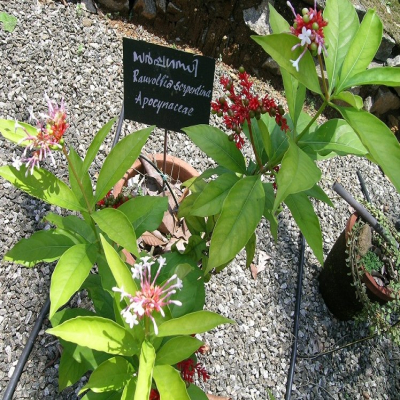Rauvolfia serpentina (Linn.) Benth. ex Kurz
Family : Apocynaceae
Group : Anti hypertensive, Antidotes
Parts Used : Root , Seed
Vernacular Names :-
| English | : | Serpentwood |
| Malayalam | : | Sarpagandhi, Amalpori |
| Hindi | : | Chandrabhaga |
| Sanskrit | : | Sarpagandha |
| Kannada | : | Sutranbli |
| Tamil | : | Chivanamalpodi |
| Telungu | : | Patalagandhi |
Distribution and habitat: Native to India. Seen in the humid tropics of India, Nepal, Burma, Thailand, Bangladesh, Indonesia, Cambodia, Philippines and Sri Lanka. In India, it is cultivated in the states of Uttar Pradesh, Bihar, Tamil Nadu, Orissa, Kerala, Assam, West Bengal and Madhya Pradesh. Thailand is the chief exporter of Rauvolfia alkaloids. In India, it has become an endangered species and hence the Government has prohibited the exploitation of wild growing plants in forest and its export since 1969.
Botany: It is an erect perennial shrub generally 15-45 cm high, but growing upto 90 cm under cultivation.
- Roots: Nearly vertical, tapering up to 15 cm thick at the crown and long giving a serpent-like appearance, occasionally branched or tortuous developing small fibrous roots. Roots greenish-yellow externally and pale yellow inside, extremely bitter in taste.
- Leaves: Born in whorls of 3-4 elliptic-lanceolate or obovate, pointed;
- Flowers: Numerous borne on terminal or axillary cymose inflorescence; corolla tubular, 5-lobed, 1-3 cm long, whitish-pink in colour; stamens 5, epipetalous; carpels 2, connate, style filiform with large bifid stigma;
- Fruit: Drupe, obliquely ovoid and purplish black in colour at maturity with stone containing 1-2 ovoid wrinkled seeds. The plant is cross-pollinated, mainly due to the protogynous flowers.
Chemical constituents: Over 200 alkaloids have been isolated from the plant. Rauvolfia root contains 1.4-3% alkaloids. The alkaloids are classified into 3 groups, viz. reserpine, ajmaline and serpentine groups.
Uses:
- Dried root is the economic part. It is a sedative and is used to control high blood pressure and certain forms of insanity.
- In ayurveda it is also used for the treatment of insomnia, epilepsy, asthma, acute stomach ache and painful delivery.
- Used in snake-bite, insect stings and mental disorders. It is popular as ‘Madman's medicine’ among tribals. ‘Serpumsil’ tablet for high blood pressure is prepared from Rauvolfia roots.
- Reserpine is a potent hypotensive and tranquillizer but its prolonged usage stimulates prolactine release and causes breast cancer.
- The juice of the leaves is used as a remedy for the removal of opacities of the cornea.
Formulations: Sarpagandhadi churnam
Agro technology
Soil and climate: Medium to deep well-drained fertile soils and clay-loam to silt-loam soils rich in organic matter are suitable for its cultivation. A tropical humid climate is ideal. Its common habitats receive an annual rainfall of 1500-3500 mm and the annual mean temperature is 10-38°C. It grows up to an elevation of 1300-1400 m from MSL. It can be grown in open as well as under partial shade conditions.
Propagation: Vegetatively by root cuttings, stem cuttings or root stumps and by seeds. Seed propagation is the best method for raising commercial plantation. Seed germination is very poor and variable from 10-74%. It is desirable to use fresh seeds and to soak in 10% sodium chloride solution. Seed rate 5-6 kg/ha.
Two months old seedlings with 4-6 leaves are transplanted at 45-60 x 30 cm spacing in July -August in the main field. Alternatively, rooted cuttings of 2.5-5 cm long roots or 12-20 cm long woody stems can also be used for transplanting.
Manuring: Fertiliser recommendation is 40:30:30 kg N: P2O5 :K2O/ha every year. N is applied in 2-3 splits.
After cultivation: In certain regions, intercropping of soybean, brinjal, cabbage, okra or chilly is done in the Rauvolfia field.
Harvesting: Harvested after 2-3 years of growth. The optimum time of harvest is in November-December when the plants shed leaves, become dormant and the roots contain maximum alkaloid content. Harvesting is done by digging up the roots by deeply penetrating implements. The roots are cleaned, washed, cut into 12-15 cm pieces and dried to 8-10% moisture. The dried roots are stored in polythene lined gunny bags in cool dry place to protect it from mould. The yield is 1.5-2.5 t/ha of dry roots. The root bark constitutes 40-45% of the total weight of root and contributes 90% of the total alkaloids yield.


